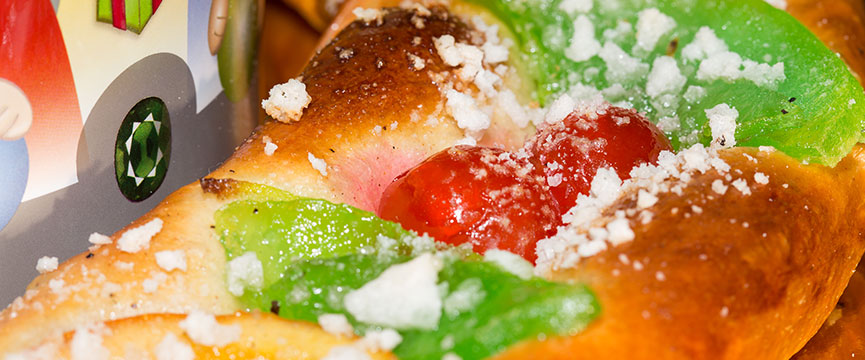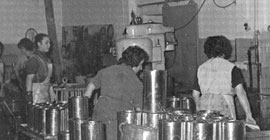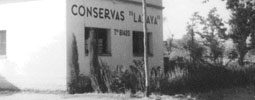 Christmas is coming, a time to spend in family, enjoy traditional dishes and sweets typical of the festive season such as turron, marzipan, polvorón shortcake, candied fruit and Roscón de Reyes which is eaten in almost every home across the land every 6th of January.
Christmas is coming, a time to spend in family, enjoy traditional dishes and sweets typical of the festive season such as turron, marzipan, polvorón shortcake, candied fruit and Roscón de Reyes which is eaten in almost every home across the land every 6th of January.

This ring-shaped cake which is usually filled with whipped cream, truffle cream or crème pâtissière (but can also be served without fillings) reached Spain at the end of the 19th century from France, although it harks back to Ancient Rome.
Upon arrival in Spain this cake was solely enjoyed by high society, but it quickly became popular and soon everyone could delight in a cake that was so unusual for the time, different as it was from traditional marzipan, puff pastries filled with cabello de ángel or cream slices.
Although modern-day Roscón de Reyes comes decorated with candied fruit and has a sweet filling, the first roscón was not served with any extra ingredients, nor was it ring-shaped, although the hole in the middle appeared shortly afterwards.
The cream, crème pâtissière or truffle cream fillings that we now enjoy only began to make an appearance in the 70s and 80s when the roscón started being made in commercial premises. The factory-baked roscones sought ever greater variety in the products they offered to the public. Nowadays roscones are made in all different shapes and sizes, with all sorts of ingredients.
Candied fruit and Roscón de Reyes
We do not know exactly when candied fruit started being used in the Roscón de Reyes. It is believed to have been toward the middle of the 20th century. Although not everyone is a fan of candied fruit on their Roscón de Reyes, it is nevertheless an essential ingredient used to this day, either due to tradition or because they add that touch of colour to the top of the cake which we are used to seeing.
Furthermore, candied fruit reacts well to the high temperatures in the oven needed to make a roscón. Candied fruit sticks perfectly to the surface of the cake. This happens because the fruit is added when the mixture is still raw and it remains intact for the rest of the time required to bake the cake, which is something that other modern ingredients such as jelly sweets cannot do.
There are many different tales relating to the reason we add candied fruit to the roscón. Some are convinced that the candied fruit represents the jewels that the Three Wise Men wore on their robes. Others say they are the jewels of a Crown and are not related to the birth of Christ and the visit of the Three Wise Men.
What is not in dispute is that candied fruit are the most traditional ingredients of a roscón de Reyes so much so that some people think that those roscones not served with candied fruit are somehow not authentic and cannot be considered as such.
What types of candied fruit are used for the Roscón de Reyes?
The most commonly used to decorate the surface of these cakes are green, red or orange in colour. The green-coloured candied fruit is made from either melon or pumpkin, with an added natural colorant to make it more vibrant. The red candied fruit is either watermelon or cherry. The orange-coloured candied fruit come from slices of oranges.
Choosing which Roscón de Reyes to buy can be quite a tricky task, given the great variety on offer. We all know that some of us like cream, others like truffle cream, and others like a crème brùlée as fillings. In fact, arguments even exist about the candied fruit. Some people love it and others remove it before eating the cake.
What hasn’t changed over time is the excitement about finding a small lucky charm inside the cake or the desire to avoid being served the broad bean in your slice of cake, which means it’s your turn to pay for the cake. This is a twist on the older tradition which featured the broad bean bringing luck to the person who found it.
How many Roscones de Reyes are sold in Spain?
The National Institute of Statistics states that each home in Spain consumes at least 1.5 roscones over the festive season and that sales are above 28 million cakes sold across all types of shops and stores, from supermarkets to bakeries and cake shops, etc.
Pastry chefs who specialise in making the Roscón de Reyes usually buy ready-made candied fruit to place on the cake and obviously they choose top quality guaranteed fruit. It is only natural that they choose candied fruit from Lazaya, which is one of the most popular brand names to feature on the best roscones. Contact us to find out how we can help.










